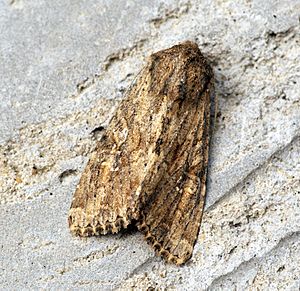Nutmeg (moth) facts for kids
Quick facts for kids Nutmeg moth |
|
|---|---|
 |
|
| Scientific classification | |
| Synonyms | |
|
The nutmeg moth (also known as the clover cutworm) is a type of moth from the Noctuidae family. It gets its name from its brownish color, which can look a bit like the spice nutmeg.
Contents
Where the Nutmeg Moth Lives
You can find the nutmeg moth in many parts of the world. It lives across western Europe, Tunisia, and Iran. You can also find it in Niger in Africa and Quebec in North America. In colder northern parts of Europe, these moths are like summer tourists. They fly there for the warmer months but cannot survive the cold winter. So, they move to warmer places.
What the Nutmeg Moth Looks Like
This moth is small to medium-sized. Its wingspan is about 33 to 39 millimeters, which is roughly the length of a few paperclips. Its front wings are usually light to dark brown. Sometimes, they might even have a reddish color. These colors help the moth blend in with its surroundings, like tree bark or leaves.
A cool feature on its front wings is a clear white line. This line looks like a "W" shape. You might see this "W" on other moths too, but it's very noticeable on the nutmeg moth. The back wings are grey or a light brownish-yellow. They are darker near the edges and have dark lines that look like veins.
Life Cycle of the Nutmeg Moth
Nutmeg moths usually have one or two groups of babies (called broods) each year. Adult moths can be seen flying from May all the way through September. These moths are active at night. They are often drawn to bright lights. They also like sweet things like sugar and the nectar from flowers.
Moths from the first group usually fly from June to early July. The second group flies from late July to September. The young moths, called larvae (or caterpillars), eat many different kinds of plants. When winter comes, the moth is in its pupa stage. It stays hidden, often underground, until it's ready to become an adult moth in the spring.
What Nutmeg Moth Larvae Eat
The caterpillars of the nutmeg moth are not picky eaters! They feed on a wide variety of plants. Here are some of their favorite foods:
- Allium (like onions)
- Amaranthus – amaranth
- Apium – celery
- Arachis – peanut
- Asparagus – asparagus
- Atriplex
- Beta – beet
- Brassica (like cabbage)
- Chenopodium – goosefoot
- Cytisus – broom
- Glycine – soybean
- Gossypium – cotton plant
- Halogeton
- Hibiscus
- Lactuca – lettuce
- Linum – flax
- Lycopersicon – tomato
- Medicago – alfalfa
- Nicotiana – tobacco
- Petroselinum – parsley
- Phaseolus – common bean
- Pisum (like peas)
- Populus – poplar
- Portulaca – purslane
- Raphanus – radish
- Rheum – rhubarb
- Ricinus – castor bean
- Salsola
- Scorzonera
- Sonchus – sow-thistle
- Spinacia – spinach
- Taraxacum – dandelion
- Trifolium – clover
- Ulmus – elm
Images for kids


